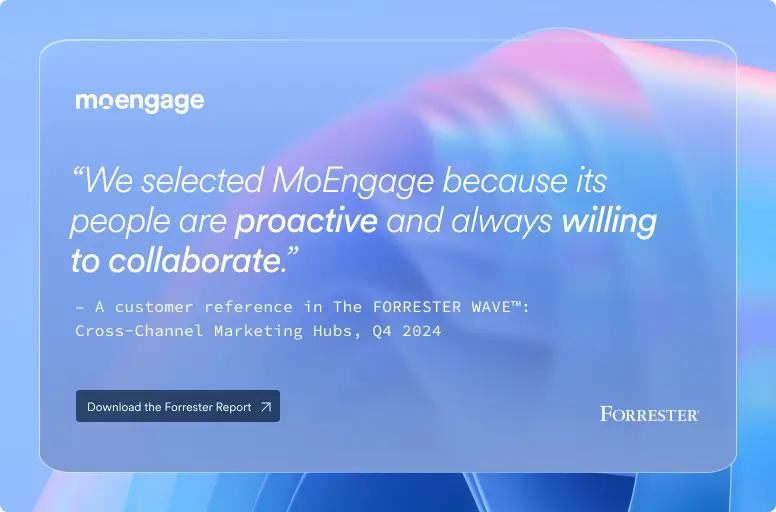🔥 [Panel] Personalization, AI, Trust—What Top BFSI Marketers Are Doing Differently.
Register Now
Any ace marketer in the world would back the importance of accurate user segmentations. This is the process of creating buckets and distinctions of your users based on behaviour and characteristics. This process further helps them better target products and ensure retention.
To discover some insight into the art of user segmentation, MoEngage held a mixer with Tobias Lüder, CRM Manager, Delivery Hero; Ada Dubrawska, Associate Product Manager (Growth), Clue; Christian Eckhardt, CEO & Co-founder, Customlytics; Jon Genovard, CRM Manager, Blacklane; and Natalie Fitch, CRM Manager-Retention & Engagement, Babbel.
Here are some of the significant takeaways from the conversion:
Marketers often create not-so-brag-worthy campaign segments. Here are some of the most absurd elements that might or might not work:
If we narrow the lens of user segmentation, the number of permutations and combinations are many. As a result, it’s often problematic for marketers to decide the right kind of segmentation with so many variables at play.
A simple way to declutter this process is by starting at the broader segments with simple parameters and then branching out the user data into more quantifiable data. The first step could be something as simple as “users who have an email ID.”
Once you make this first step, it’s easier to find co-relations and create smaller and functional segmentations.
If you are running a premium product that is of higher spending, you can use the model of a golden customer. In such a case, over eighty per cent of the revenue will come from only twenty per cent of the consumers. Thus, spending criteria can easily segment the top customer.
Many marketers are so highly driven by retention that they tend to ignore the high-paying consumer. It’s critical always to give more attention to these power consumers for sustenance.
The best way to set up effective customer resource management is by thinking from the consumer’s perspective and not the company.
The most important foundation is the correct data. Ensure that the tracking setup is accurate and effective. It’s a massive disadvantage to the business if you misread the data and do not segment users correctly.
The ideal groundwork for CRM is a chronological approach. Retention starts on the first step, that is, onboarding, and flows in a natural progression of the consumer journey. One must also pay close attention to the Opt-in and Opt-out points of any campaign.
Lastly, you must use data wisely. For example, if you are a food-delivery application, never ask people for a birthday; that is not something you need. Instead, use data that matters like season count or last order date.
The most critical aspect to running effective marketing is the need for constant improvement. However, there are a few ways to keep these in check.
The best route is to conduct control groups often and conduct A-B testing. However, it’s also essential to define the purpose of the campaign; some are intended for profit while others are just activations.
One must also look at efficiency in the workflow. Consider a combination of both leading and lagging matrices. Only counting a win will not lead to progress. The ultimate aim, however, is a flat retention curve.
One of the simplest ways to improve efficiency is automation. Without automation, the team will inevitably spend numerous hours on sends and analytics.
Push notifications could be one of the most hard-to-understand matrices and the most abused tool for marketers. It’s essential to test its efficiency and optimize it often. Here are a few pointers:
While user segmentation is solely based on data, this could raise a series of privacy concerns. So, here are a few ways marketers can keep a tab on privacy:
Lastly, the core company and the marketing limbs must all remain on the same page. Getting the perfect user segmentation is redundant if you cannot feel this data back to the product teams.
This feedback is possible by hosting open communications channels within the establishment, organizing monthly brainstorms, and ensuring all limbs (even support and social media) are part of tracking and feedback.
Be the first to access actionable reports, guides, tips, videos, podcasts from experts in Customer Engagement, retention and more!





MoEngage is an insights-led platform trusted by 1,350+ global brands like McAfee, Flipkart, Domino’s, Nestle, Deutsche Telekom, and more. MoEngage’s powerful analytics, personalization, and AI capabilities give a 360-degree view of your customers and help you create journeys across digital channels.
© Copyright 2025 MoEngage. All Rights Reserved.

Please wait while you are redirected to the right page...
